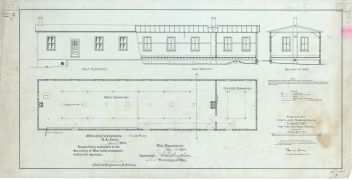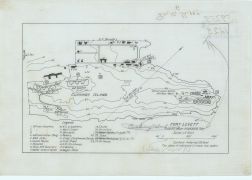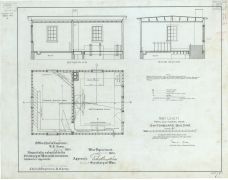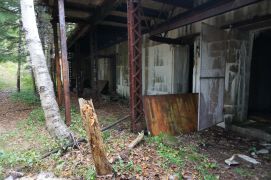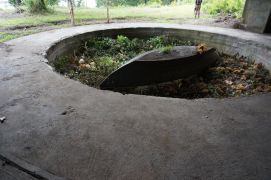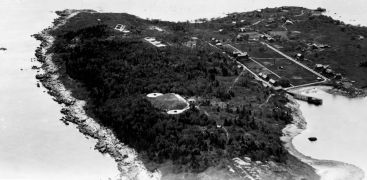Fort Levett: Difference between revisions
J. Malcolm (talk | contribs) |
J. Malcolm (talk | contribs) |
||
| Line 2: | Line 2: | ||
== Endicott Era == | == Endicott Era == | ||
In 1894 the government exercised its right to eminent domain and took control of the land from Francis Cushing. The initial parcel of land was 33.75 acres which was deemed too small for military use. In 1904 the reservation was increased by 91.68 acres bringing the total to 127 acres. The fort was officially named on April 4th, 1900, after Christopher Levett who explored Casco Bay in the 1620s. No construction on any part of the fort would begin until 1897. Four batteries were planned for the site in 1898. Railroad beds, drains, concrete mixing wells and other necessary infrastructure were prepared for construction and completed by 1899. The concrete work was started in 1900 on Battery | In 1894 the government exercised its right to eminent domain and took control of the land from Francis Cushing. The initial parcel of land was 33.75 acres which was deemed too small for military use. In 1904 the reservation was increased by 91.68 acres bringing the total to 127 acres. The fort was officially named on April 4th, 1900, after Christopher Levett who explored Casco Bay in the 1620s and was designated a sub post of [[Fort Williams]]. No construction on any part of the fort would begin until 1897. Four batteries were planned for the site in 1898. Railroad beds, drains, concrete mixing wells and other necessary infrastructure were prepared for construction and completed by 1899. The concrete work was started in 1900 on Battery Bowdoin and Kendrick. A narrow-gauge railway was completed in 1899 that connected each of the batteries. On August 26-29 a mock battle was created to test how strong the Naval ships were and how strong the Coast Artillery Forts were. Fort Levett did take part in this experiment. In 1904 most all of the main post buildings were built. The central powerhouse was completed June 30th, 1905 for $52,600 along the parade ground with three Westinghouse 105 Horsepower steam engines that were purchased in 1903. This powerhouse would provide electricity for all of the tactical buildings at Fort Levett. Two 30-inch truck-mounted searchlights were transferred to Fort Levett on December 26th, 1905. On January 29th, 1909 a number of buildings were accepted for service including the switchboard building, dormitory, combined secondar station for [[Fort Williams]], Fire Command Positions and Base-End Stations for Batteries Chase, Bowdoin and Kendrick. Secondary Fire Control positions for Fort Levett were located in another stucco building at [[Fort Williams]]. On August 26th, 1909 another group of buildings were accepted for service including the district signal station, BC Stations for Batteries Bowdoin and Kendrick, the meteorological station and tide gauge station. In 1911 a brand-new searchlight powerhouse was built near whitehead to serve two 60-inch searchlights transferred April 28th, 1911. <gallery mode="packed"> | ||
File:TempDorm.jpg|alt= | File:TempDorm.jpg|alt= | ||
File:QuadFCS.jpg|alt= | File:QuadFCS.jpg|alt= | ||
| Line 14: | Line 14: | ||
</gallery> | </gallery> | ||
== Battery | == Battery Bowdoin == | ||
Construction on this three-gun 12-inch disappearing battery started in 1899. Originally planned for four guns, only three emplacements were built. Emplacements #4 and #3 were completed in 1901 and emplacement #2 was completed in 1902. In 1902 it was decided to eliminate the fourth emplacement. Each emplacement was armed with M1897 disappearing carriages and M1895 12-inch rifles which were all installed by 1903 | Construction on this three-gun 12-inch disappearing battery started in 1899. Originally planned for four guns, only three emplacements were built. Emplacements #4 and #3 were completed in 1901 and emplacement #2 was completed in 1902. In 1902 it was decided to eliminate the fourth emplacement. Each emplacement was armed with M1897 disappearing carriages and M1895 12-inch rifles which were all installed by 1903. The battery was transferred for use on April 23rd, 1903 at a cost of $190,290.56. This battery was named in 1900 after James Bowdoin who was the governor of Massachusetts in the late 1700s. Three hodges back delivery hoists were installed originally but on April 15th, 1919 three new Taylor-Raymond back delivery hoists were installed in their place. In 1918 generators were installed to serve the battery and all of whitehead as auxiliary. <gallery mode="packed"> | ||
File:BowdinPlan.jpg|alt= | File:BowdinPlan.jpg|alt= | ||
File:Fort Levett Batteries.jpg|alt= | File:Fort Levett Batteries.jpg|alt= | ||
| Line 24: | Line 24: | ||
== Battery Kendrick == | == Battery Kendrick == | ||
Construction on this two-gun 10-inch disappearing gun battery started in 1899 along with Battery Bowdin. Construction was mostly completed by 1901 and the battery was armed in 1902 and transferred into service | Construction on this two-gun 10-inch disappearing gun battery started in 1899 along with Battery Bowdin. Construction was mostly completed by 1901 and the battery was armed in 1902 and transferred into service on April 23rd, 1903 with two M1895 10-inch rifles on M1896 disappearing carriages for $118,578.20. This battery was named in honor of Henry Lane Kendrick who was a science professor. Two Hodges back delivery hoists were provided along with Type-C powder hoists. When Battery Ferguson was planned, it was to be adjacent to this battery which resulted in the widening of Battery Kendrick's loading platforms where emplacement #1 met Battery Ferguson. In 1918 generators were installed to serve Battery Ferguson and Daniels along with the Fire Command group as auxiliary. In 1919 the original Hodges shell hoists were replaced with Taylor Raymond Hoists. <gallery mode="packed"> | ||
File:Fort Levetts 16.jpg|alt= | File:Fort Levetts 16.jpg|alt= | ||
File:KendrickPlan.jpg|alt= | File:KendrickPlan.jpg|alt= | ||
| Line 33: | Line 33: | ||
== Battery Ferguson == | == Battery Ferguson == | ||
Plans for this battery were created in 1901. Originally this battery was to hold four 6-inch guns mounted on pedestal mounts but during initial construction in 1902 this plan was altered to only have two guns per emplacement. The battery was named in 1903 after William Ferguson who served in the American Revolution. The battery was completed in 1904. In 1906 M1900 rifles and barbette mounts were installed on the battery, and it was transferred for use. <gallery mode="packed"> | Plans for this battery were created in 1901. Originally this battery was to hold four 6-inch guns mounted on pedestal mounts but during initial construction in 1902 this plan was altered to only have two guns per emplacement. The battery was named in 1903 after William Ferguson who served in the American Revolution. The battery was completed in 1904. In 1906 M1900 rifles and barbette mounts were installed on the battery, and it was transferred for use on June 22nd, 1906 for $58,500. Two Hodges back delivery hoists were provided. <gallery mode="packed"> | ||
File:Fergusen1905plan.jpg|alt= | File:Fergusen1905plan.jpg|alt= | ||
File:Fort Levett Batteries.jpg|alt= | File:Fort Levett Batteries.jpg|alt= | ||
| Line 39: | Line 39: | ||
== Battery Daniels == | == Battery Daniels == | ||
Construction on this three-gun 3-inch rapid fire battery started in 1899. It was designed to protect and sweep the minefield. The battery was completed in 1900 and armed in 1901 with M1898 mounts and M1898 rifles. The battery was transferred after being named for Napoleon Daniels who served in the Civil War. | Construction on this three-gun 3-inch rapid fire battery started in 1899. It was designed to protect and sweep the minefield. The battery was completed in 1900 and armed in 1901 with M1898 mounts and M1898 rifles. The battery was transferred April 23rd, 1903 for $14,994,18 after being named for Napoleon Daniels who served in the Civil War. In 1920 a program was started to remove all unnecessary small caliber guns. The guns of Battery Daniels were removed, and the mounts salvaged. | ||
== WWI Era == | == WWI Era == | ||
| Line 48: | Line 48: | ||
== Battery Foote == | == Battery Foote == | ||
<gallery mode="packed"> | Construction was authorized in 1917 for a new long range 12" gun battery. Initially, two batteries were planned for the site but the second was eliminated before construction could begin. This battery was completed January 26th, 1921 and named in honor of Stephen M Foote<gallery mode="packed"> | ||
File:Fort Levetts 12.jpg|alt= | File:Fort Levetts 12.jpg|alt= | ||
File:Fort Levetts 11.jpg|alt= | File:Fort Levetts 11.jpg|alt= | ||
Revision as of 17:38, 27 May 2024
Fort Levett is a former Coastal Defense site established in 1894 on Cushings Island in Casco Bay. The fort was used through WWII and abandoned shortly after. Location 161.
Endicott Era
In 1894 the government exercised its right to eminent domain and took control of the land from Francis Cushing. The initial parcel of land was 33.75 acres which was deemed too small for military use. In 1904 the reservation was increased by 91.68 acres bringing the total to 127 acres. The fort was officially named on April 4th, 1900, after Christopher Levett who explored Casco Bay in the 1620s and was designated a sub post of Fort Williams. No construction on any part of the fort would begin until 1897. Four batteries were planned for the site in 1898. Railroad beds, drains, concrete mixing wells and other necessary infrastructure were prepared for construction and completed by 1899. The concrete work was started in 1900 on Battery Bowdoin and Kendrick. A narrow-gauge railway was completed in 1899 that connected each of the batteries. On August 26-29 a mock battle was created to test how strong the Naval ships were and how strong the Coast Artillery Forts were. Fort Levett did take part in this experiment. In 1904 most all of the main post buildings were built. The central powerhouse was completed June 30th, 1905 for $52,600 along the parade ground with three Westinghouse 105 Horsepower steam engines that were purchased in 1903. This powerhouse would provide electricity for all of the tactical buildings at Fort Levett. Two 30-inch truck-mounted searchlights were transferred to Fort Levett on December 26th, 1905. On January 29th, 1909 a number of buildings were accepted for service including the switchboard building, dormitory, combined secondar station for Fort Williams, Fire Command Positions and Base-End Stations for Batteries Chase, Bowdoin and Kendrick. Secondary Fire Control positions for Fort Levett were located in another stucco building at Fort Williams. On August 26th, 1909 another group of buildings were accepted for service including the district signal station, BC Stations for Batteries Bowdoin and Kendrick, the meteorological station and tide gauge station. In 1911 a brand-new searchlight powerhouse was built near whitehead to serve two 60-inch searchlights transferred April 28th, 1911.
Battery Bowdoin
Construction on this three-gun 12-inch disappearing battery started in 1899. Originally planned for four guns, only three emplacements were built. Emplacements #4 and #3 were completed in 1901 and emplacement #2 was completed in 1902. In 1902 it was decided to eliminate the fourth emplacement. Each emplacement was armed with M1897 disappearing carriages and M1895 12-inch rifles which were all installed by 1903. The battery was transferred for use on April 23rd, 1903 at a cost of $190,290.56. This battery was named in 1900 after James Bowdoin who was the governor of Massachusetts in the late 1700s. Three hodges back delivery hoists were installed originally but on April 15th, 1919 three new Taylor-Raymond back delivery hoists were installed in their place. In 1918 generators were installed to serve the battery and all of whitehead as auxiliary.
Battery Kendrick
Construction on this two-gun 10-inch disappearing gun battery started in 1899 along with Battery Bowdin. Construction was mostly completed by 1901 and the battery was armed in 1902 and transferred into service on April 23rd, 1903 with two M1895 10-inch rifles on M1896 disappearing carriages for $118,578.20. This battery was named in honor of Henry Lane Kendrick who was a science professor. Two Hodges back delivery hoists were provided along with Type-C powder hoists. When Battery Ferguson was planned, it was to be adjacent to this battery which resulted in the widening of Battery Kendrick's loading platforms where emplacement #1 met Battery Ferguson. In 1918 generators were installed to serve Battery Ferguson and Daniels along with the Fire Command group as auxiliary. In 1919 the original Hodges shell hoists were replaced with Taylor Raymond Hoists.
(Powder hoists installed in 1912-Type C)
Battery Ferguson
Plans for this battery were created in 1901. Originally this battery was to hold four 6-inch guns mounted on pedestal mounts but during initial construction in 1902 this plan was altered to only have two guns per emplacement. The battery was named in 1903 after William Ferguson who served in the American Revolution. The battery was completed in 1904. In 1906 M1900 rifles and barbette mounts were installed on the battery, and it was transferred for use on June 22nd, 1906 for $58,500. Two Hodges back delivery hoists were provided.
Battery Daniels
Construction on this three-gun 3-inch rapid fire battery started in 1899. It was designed to protect and sweep the minefield. The battery was completed in 1900 and armed in 1901 with M1898 mounts and M1898 rifles. The battery was transferred April 23rd, 1903 for $14,994,18 after being named for Napoleon Daniels who served in the Civil War. In 1920 a program was started to remove all unnecessary small caliber guns. The guns of Battery Daniels were removed, and the mounts salvaged.
WWI Era
Battery Foote
Construction was authorized in 1917 for a new long range 12" gun battery. Initially, two batteries were planned for the site but the second was eliminated before construction could begin. This battery was completed January 26th, 1921 and named in honor of Stephen M Foote
WWII Era
Battery AMTB 962
WWII FIRE CONTROL STATIONS & RADARS
Site 1B Mine Observation Station
Site 1E Fire Control Tower
Site 1G SCR 296-3 (Radar)
Site 1H Fire Control Tower
Site 1J Gun-Group Command Post
Present
Privately owned since 1957
SOURCES and REFERENCES
Battery Foote=Battery #4
Battery Ferguson=Battery #3
Battery Foote used for storing banks records.
Whiteheads FCS razed 1960s
Officers Duplex burned after 1970
Barracks burned 1970
